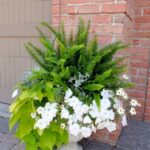Small gardens may be limited in space, but they are far from lacking in beauty and potential. In fact, these intimate outdoor spaces have been gaining popularity as people seek to bring nature into more compact living environments. With the right design and layout, a small garden can become a tranquil oasis, a productive food source, or simply a visually stunning extension of your indoor living space.
Well-designed layouts for small gardens offer numerous benefits. Firstly, they maximize every inch of available space to create functional areas for various activities, such as dining, lounging, or gardening. Efficient use of space is crucial in small gardens where every square foot counts. Secondly, a well-designed layout enhances visual appeal by creating balance and harmony between different elements like plants, structures, and pathways. This can make even the tiniest garden appear larger and more inviting.
Not only do small gardens provide physical and visual pleasure, but they also offer mental and emotional benefits. They provide an escape from the hustle and bustle of daily life in urban areas, allowing individuals to reconnect with nature even within limited surroundings. Studies have shown that spending time in green spaces can reduce stress levels, improve mood, enhance cognitive function, and foster overall wellbeing.
By understanding the significance of small gardens and recognizing the advantages of well-designed layouts, you can unlock the full potential of your compact outdoor space. Whether you have a tiny balcony or a modest backyard area at your disposal, there are plenty of creative solutions to turn it into a vibrant and fulfilling garden retreat. In the following sections of this article, we will delve deeper into various aspects that contribute to successful small garden designs and layouts.
Assessing Your Small Garden
When it comes to designing a small garden, the first step is to assess the available space and understand its limitations. By thoroughly understanding your garden’s size and shape, you can make informed decisions about what will work best in your space and create a layout that maximizes its potential.
One way to assess your small garden is by measuring the dimensions of the area. Use a tape measure or yardstick to determine both the length and width of your outdoor space. This will give you an accurate idea of how much room you have to work with when it comes to plant placement, hardscaping, and creating zones within your garden.
Another important consideration when assessing your small garden is understanding any limitations or challenges posed by the environment. Take note of factors such as sunlight exposure, soil conditions, and drainage patterns. These factors will influence which plants will thrive in your space and what adjustments you may need to make in terms of irrigation or soil amendments.
Additionally, consider any existing structures or features within your small garden that may impact design choices. For example, if you have a tree located near one corner of your garden, you may want to design around it rather than attempting to remove it. Likewise, if there is a permanent fixture like a shed or fence, think about how it can be incorporated into the overall layout of your garden.
Overall, thoroughly assessing your small garden provides crucial information for making design decisions that are both practical and visually appealing. By understanding the available space and its limitations from the outset, you can create a well-designed layout that makes the most efficient use of every square foot.
Choosing the Right Plants
- Consider the size: Look for plants that will fit well within the available space. Choose compact or dwarf varieties that won’t outgrow their allotted area. This will help prevent overcrowding and ensure that each plant has enough room to grow and flourish.
- Pay attention to growth habits: Different plants have different growth habits, such as upright, spreading, or trailing. Consider the growth habit of each plant and how it will interact with neighboring plants. Avoid selecting plants with vigorous spreading tendencies that can quickly take over limited space.
- Opt for multi-functional plants: Select plants that offer more than just visual appeal. Look for plants that provide additional benefits such as attracting pollinators, repelling pests, or producing edible fruits or herbs. This way, you can maximize the functionality of your small garden.
- Prioritize low-maintenance options: In a small garden, it is essential to choose plants that require minimal care and upkeep. Look for hardy species that are suitable for your climate and can withstand fluctuations in temperature and weather conditions.
- Consider vertical gardening options: Take advantage of vertical space by incorporating climbing vines, espaliered trees, or trellises into your small garden design. These types of plants can add height and visual interest without taking up valuable ground space.
Remember to also consider factors such as sunlight requirements, soil conditions, and water needs when selecting plants for your small garden. By choosing the right plant species and varieties, you can create a thriving and visually appealing oasis in even the smallest of spaces.
Maximizing Vertical Space
When designing a small garden, it’s essential to make the most of every inch of available space. One effective way to do this is by maximizing vertical space. By using walls, trellises, and hanging planters, you can add greenery and create a visually appealing vertical garden.
One strategy for utilizing vertical space is to install trellises against walls or fences. This not only adds height but also provides support for climbing plants such as vines and flowering climbers. Trellises come in various styles and materials, allowing you to choose one that complements the overall aesthetic of your garden. Consider fast-growing species like clematis or morning glories that will quickly cover the trellis and provide a beautiful backdrop.
Another option is to utilize hanging planters. These suspended containers can be attached to walls, deck railings, or overhead structures like pergolas or arbors. Hanging planters are ideal for growing trailing and cascading plants like ivy or petunias. They not only add a lush look to your small garden but also save valuable ground space.
In addition to wall-mounted options, you can also explore the use of vertical gardening systems specially designed for maximizing space in small gardens. These systems typically consist of modular panels or grids that allow you to grow plants vertically by attaching pots or planting pockets. Some systems even incorporate irrigation channels for easy watering and maintenance.
Maximizing vertical space in your small garden not only adds greenery but also creates an interesting visual element. By incorporating trellises, hanging planters, or vertical gardening systems, you can take advantage of available wall space and transform your garden into a vibrant oasis.
| Benefit | Data |
|---|---|
| Increased greenery and plant variety | Vertical gardening allows you to grow more plants in limited space, adding visual interest and biodiversity. |
| Saves valuable ground space | Utilizing walls, trellises, and hanging planters frees up floor space for seating areas or other functional elements. |
| Creates an attractive focal point | A well-designed vertical garden adds height and dimension to your small garden, drawing the eye upward and creating a visually appealing feature. |
Creating Zones
When designing a small garden, it is essential to create zones within the space to maximize functionality and visual appeal. By strategically dividing the garden into different areas, you can make the most of limited space and create a sense of organization and purpose. Here are some tips on how to create zones in your small garden.
Define the Purpose
Before dividing your garden into zones, think about how you want to use each area. Consider your needs and preferences – do you want a separate space for dining, entertaining, or relaxation? Do you need space for children or pets to play? Defining the purpose of each zone will help you determine how much space to allocate and guide your design decisions.
Use Plants as Borders
One effective way to create zones in a small garden is by using plants as natural borders. Different types of plants can visually separate different areas while still maintaining a cohesive design. For example, tall grasses or shrubs can be used as screens to separate an outdoor sitting area from a vegetable garden or play area. Just be sure to consider the growth habits of the plants so they don’t take up too much space or become overwhelming.
Add Functional Elements
To optimize functionality in your small garden, consider adding functional elements that clearly define each zone’s purpose. This could include installing a pergola or gazebo for an outdoor seating area, creating raised garden beds for growing vegetables, or building a fire pit for a cozy gathering spot. By incorporating these elements into your garden design, you not only divide the space but also enhance its usability and appeal.
By carefully creating zones within your small garden, you can make the most of every inch while still achieving an aesthetically pleasing layout. Remember to consider the purpose of each zone, use plants as natural dividers, and add functional elements to optimize functionality. With these strategies, you can create a small garden that is both practical and visually appealing.
Incorporating Hardscape Elements
When designing a small garden, it is important to consider not only the plants but also the hardscape elements that can add structure and function to the space. Hardscaping refers to the use of non-living elements such as paving, pathways, and containers to create an organized layout and define different areas within the garden. These elements not only provide visual interest but also serve practical purposes in terms of accessibility and maintenance.
One effective way to incorporate hardscape elements in a small garden is through the use of paving. Paved surfaces can create a sense of order and simplicity while also providing a solid foundation for furniture or plant containers. For smaller gardens, it is best to choose smaller-scale pavers or tiles to avoid overwhelming the space. Additionally, using different materials and patterns can add texture and visual appeal to the overall design.
Pathways are another essential hardscape element that adds structure and helps guide visitors through the garden. In a small garden, pathways can be strategically placed to create interesting focal points or lead to different zones within the space. Consider using materials such as gravel, stepping stones, or even reclaimed bricks for a charming rustic look. It is important to ensure that pathways are wide enough for comfortable navigation without encroaching on valuable planting space.
Containers are versatile hardscape elements that can be used in multiple ways in a small garden design. They not only provide structure but also allow for flexibility in terms of plant selection and placement.
Strategically placing containers at different heights throughout the garden can add vertical interest and maximize growing space. Consider using pots made from materials like terracotta or ceramic for a timeless aesthetic, or opt for modern options like sleek metal or colorful plastic containers for a contemporary look.
Incorporating these hardscape elements into your small garden design will help create a visually appealing and organized outdoor space. By utilizing paving, pathways, and containers, you can add structure while also optimizing functionality and accessibility. Additionally, these elements provide opportunities for personalization and creativity, allowing you to truly make the space your own.
Designing With Colors and Textures
When it comes to creating a visually appealing small garden, colors and textures play a crucial role. By carefully selecting plants and incorporating various garden accessories, you can add depth and visual interest to your outdoor space.
One way to introduce color into your small garden is by opting for plants with vibrant blooms. Choose flowers in different shades such as red, pink, purple, or yellow to create a visually striking display. Consider planting these colorful flowers in clusters or borders to make them stand out even more. Additionally, you can incorporate foliage plants with contrasting hues of green and burgundy to create texture and visual variation.
Another way to enhance the visual appeal of your small garden is by using garden accessories strategically. Place decorative pots and planters throughout your garden to add pops of color and texture. Opt for containers in various shapes, sizes, and materials such as ceramic, terracotta, or metal to create an eclectic look. You can also hang baskets filled with trailing plants or install vertical planters on walls or fences to maximize space while adding an interesting visual element.
In addition to plants and garden accessories, consider incorporating other design elements that contribute to the overall aesthetics of your small garden. Install a focal point such as a sculpture or water feature that catches the eye and adds interest. Add pathways made of different materials like gravel or stepping stones to create texture and guide visitors through the space. Incorporate seating areas with comfortable outdoor furniture where you can relax and enjoy the beauty of your garden.
By carefully considering colors, textures, and the placement of plants and accessories in your small garden design, you can transform it into a visually captivating oasis. Experiment with different combinations of colors, shapes, sizes, and materials until you achieve a look that reflects your personal style while making the most of limited space. With some creativity and careful planning, even a small garden can become a stunning and inviting outdoor retreat.
Small Garden Must-Haves
In order to maintain a small garden effectively, there are a few essential tools, lighting options, and watering systems that every gardener should consider. These must-haves not only make gardening tasks easier and more efficient but also help create an aesthetically pleasing outdoor space.
Essential Tools
When it comes to maintaining a small garden, having the right tools is crucial. Some essential tools to include in your gardening arsenal are gloves, hand trowel, pruners or secateurs, rake, shovel, and a watering can or hose. These tools will help you with various tasks such as planting, pruning, raking leaves, digging soil, and watering your plants.
Lighting Options
Having proper lighting in your small garden not only enhances its visual appeal but also allows you to enjoy the space during the evening hours. There are several lighting options available for small gardens such as string lights, solar-powered lanterns or stake lights, pathway lights, and spotlights. Consider incorporating these lighting elements strategically to highlight certain areas of your garden or create a cozy ambiance for outdoor gatherings.
Watering Systems
Efficient watering is essential for the health and growth of plants in a small garden. One option for convenient watering is installing an irrigation system that includes drip emitters or soaker hoses. These systems provide water directly to plant roots while minimizing water wastage. Additionally, having a rain barrel to collect rainwater can be an eco-friendly way to supplement your watering needs during dry periods.
Implementing Sustainable Practices
Water conservation should be a top priority when designing your small garden. One way to achieve this is by installing a rainwater harvesting system. This system collects rainwater from rooftops or other surfaces and stores it for later use in watering plants. You can connect rain barrels or cisterns to downspouts to capture rainwater more efficiently. Using collected rainwater instead of tap water for irrigation helps conserve water resources and reduces your water bill.
When selecting plants for your small garden, choose ones that are well-suited for your climate and soil conditions. Native plants are often the best choice as they have adapted to the local environment and require less maintenance. They are also more resistant to pests and diseases, reducing the need for chemical pesticides or herbicides. Additionally, consider planting drought-tolerant species that can thrive with minimal watering once established.
Incorporating eco-friendly gardening methods such as composting and mulching can significantly benefit your small garden’s sustainability. Composting allows you to recycle organic waste like kitchen scraps and yard trimmings into nutrient-rich soil amendments. This reduces landfill waste and provides natural fertilizers for your plants. Mulching, on the other hand, helps retain moisture in the soil, suppresses weeds, and improves overall soil health.
By implementing these sustainable practices in your small garden, you not only contribute to environmental conservation but also create a more self-sufficient and cost-effective space. Embracing water conservation techniques, smart planting choices, and eco-friendly gardening methods will help ensure that your small garden thrives while minimizing its ecological footprint.
Showcasing Inspirational Small Garden Designs
In this article, we have explored the world of small garden designs and layouts, discovering the many ways in which these outdoor spaces can be transformed into stunning havens. From assessing the available space and choosing the right plants to maximizing vertical space and incorporating hardscape elements, we have seen that even the tiniest of gardens can be turned into a beautiful oasis.
One of the most valuable aspects of this article is the showcase of real-life examples of small garden designs. By providing these inspirational examples, we hope to spark creativity and ideas in our readers. These designs demonstrate that limitations in space should not deter us from creating a garden that reflects our style and brings us joy.
It is important to note that small gardens require careful consideration of design elements such as colors, textures, zoning, and sustainability practices. By strategically dividing the garden into zones and utilizing plants with varying colors and textures, we can create visual interest even in a small space. Furthermore, incorporating hardscape elements such as paving, pathways, and containers can provide structure and organization to the garden.
To ensure efficient maintenance in small gardens, it is essential to have the right tools at hand. Additionally, considering lighting options and implementing watering systems are important for both functionality and aesthetics. Moreover, by incorporating sustainable practices such as water conservation techniques and smart planting choices, we can contribute to an eco-friendly approach to gardening.
Overall, transforming a small garden into a beautiful sanctuary requires thoughtful planning and creative thinking. By drawing inspiration from real-life examples showcased in this article’s exploration of small garden designs and layouts, we encourage our readers to unleash their imagination and create their own unique retreats. The possibilities are endless when it comes to designing a small garden that brings joy and harmony into our lives.

Welcome to my gardening blog! I am passionate about plants and enjoy sharing my knowledge and experiences with others. In this blog, I will write about everything related to gardening, from tips on how to get started to updates on my own garden projects.





